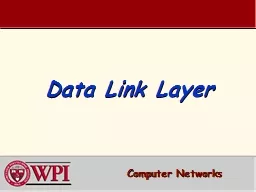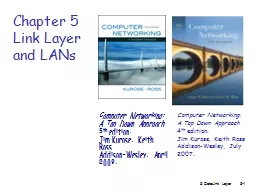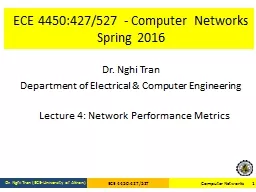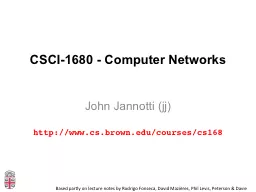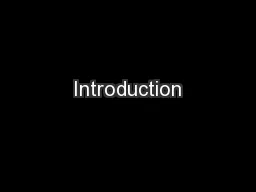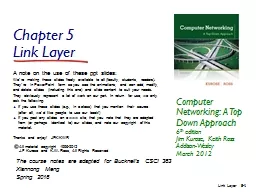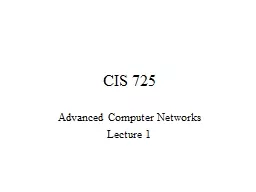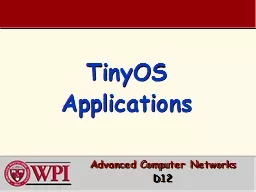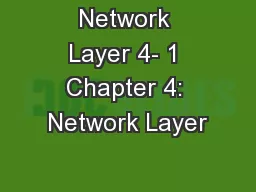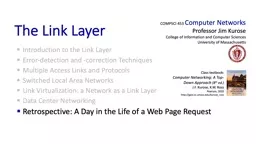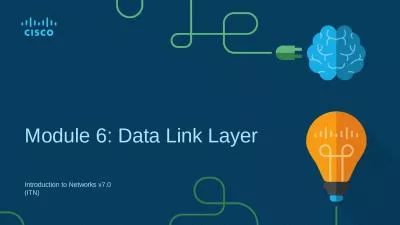PPT-Data Link Layer Computer Networks
Author : yoshiko-marsland | Published Date : 2018-09-22
Data Link Layer Outline Parallelism between Transport and Data Link Layer Tanenbaums TreatmentModel of Data Link Layer Protocol 1 Utopia Protocol 2 StopandWait Protocol
Presentation Embed Code
Download Presentation
Download Presentation The PPT/PDF document "Data Link Layer Computer Networks" is the property of its rightful owner. Permission is granted to download and print the materials on this website for personal, non-commercial use only, and to display it on your personal computer provided you do not modify the materials and that you retain all copyright notices contained in the materials. By downloading content from our website, you accept the terms of this agreement.
Data Link Layer Computer Networks: Transcript
Data Link Layer Outline Parallelism between Transport and Data Link Layer Tanenbaums TreatmentModel of Data Link Layer Protocol 1 Utopia Protocol 2 StopandWait Protocol 3 Positive Acknowledgment with Retransmission . brPage 1br DataLink Layer 1 DataLink Layer 2 DataLink Layer 3 DataLink Layer 4 DataLink Layer 5 DataLink Layer 6 brPage 2br DataLink Layer 7 DataLink Layer 8 DataLink Layer 9 DataLink Laye 5-. 1. Chapter 5. Link Layer and LANs. Computer Networking: A Top Down Approach . 4. th. edition. . Jim Kurose, Keith Ross. Addison-Wesley, July 2007. . Computer Networking: A Top Down Approach . 5. Layer Review. . Advanced Computer Networks. Advanced Computer Networks . Data Link Layer. Data Link Layer. Provides a . well-defined service interface. to the network layer.. Determines how the bits of the physical layer are grouped into frames . Spring . 2016. Dr. . Nghi. Tran. Department of Electrical & Computer Engineering. Lecture 4: Network Performance Metrics. Dr. . Nghi. Tran (ECE-University of Akron). ECE 4450:427/527. Computer Networks . John . Jannotti. (. jj. ). http://www.cs.brown.edu/courses/cs168. Based partly on lecture notes by . Rodrigo Fonseca, David . Mazières. , Phil . Levis, . Peterson & Davie. Cast. Instructor: . John . Chapter 1. Computer Networks. , Fifth Edition by Andrew . Tanenbaum. and David . Wetherall. , © Pearson Education-Prentice Hall, 2011. Uses of Computer Networks. Business Applications. Home Applications. 6. th. edition . Jim Kurose, Keith Ross. Addison-Wesley. March 2012. A note on the use of these . ppt. slides:. We. ’. re making these slides freely available to all (faculty, students, readers). They. Lecture 1. . Email: gurdip@ksu.edu. http://www.cis.ksu.edu/~singh. Phone: (785) 532-7945. Fax: (785) 532-7353. Nichols 234C. Books. Computer Networks (not required). Andrew . Tanenbaum. Approach . 7. th. edition . Jim Kurose, Keith Ross. Pearson/Addison Wesley. April 2016. Chapter . 6. The Link Layer . and LANs. 6. -. 1. Link Layer and LANs. A note on . these slides. :. The slides used in this class were derived from ones provided by Jim Kurose and Keith Ross, authors of the textbook for the course.. D12. . TinyOS. Applications Outline. AntiTheft. . Example . {done in gradual pieces}. LEDs, timer, booting. Sensing Example. Light Sensor. Wiring to . AntiTheft. Single Hop Networks. Active Messages interface. 4. 1 Introduction. 4.2 Virtual circuit and datagram networks. 4.3 What’s inside a router. 4.4 IP: Internet Protocol. Datagram format. IPv4 addressing. ICMP. IPv6. 4.5 Routing algorithms. Link state. (a richer representation of data). Credits. Oludare Adeniji, OR at NPS. Victor Castro, CS at NPS. David Cohick, OR at NPS. Brian Crawford, CS at NPS. Ralucca Gera. , . MA at NPS. Ryan Miller. , . MA at USMA. . Error-detection and -correction Techniques. Multiple Access Links and Protocols. Switched Local Area Networks . Link Virtualization: a Network as a Link Layer . Data Center Networking . Retrospective: A Day in the Life of a Web Page Request. Introduction to Networks v7.0 (ITN). Module Objectives. Module Title: . Data Link Layer. Module Objective. : Explain how media access control in the data link layer supports communication across networks.
Download Document
Here is the link to download the presentation.
"Data Link Layer Computer Networks"The content belongs to its owner. You may download and print it for personal use, without modification, and keep all copyright notices. By downloading, you agree to these terms.
Related Documents

